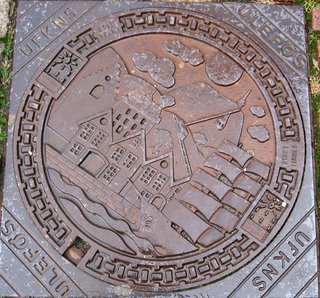 More heritage in a manhole cover, Bergen
More heritage in a manhole cover, BergenOn each side of the design is a small inscription in Norwegian and English: Cultural city of Bergen
Bergen has very few camp sites for a town that attracts so many international tourists, so we are still at the same one. It's Ibsen's choice really! It is scruffy, there are no hooks in the showers which operate on a ten kroner coin with the coin box in the communal area serving both sexes. As Val commented in her recent email, one of the biggest delights about returning home will surely be having our own bathroom back!
There is a reasonable bus service down into the centre of Bergen from near the campsite. Unfortunately the twenty five minute ride costs £6 each return and takes in the out of town shopping centre and a two kilometre tunnel on the way - hardly the most auspicious approach to Norway's second city where the centre is on the Unesco World Heritage list.
The town is very agreeable, concentrated round the port where we checked out our route for catching the ferry home next week. The largest three-masted barque in the world and Norway's oldest square-rigged sailing ship is moored here, the Staadsrad Lehmkuhl, launched in 1914. It has won numerous first prizes in tall ships races.
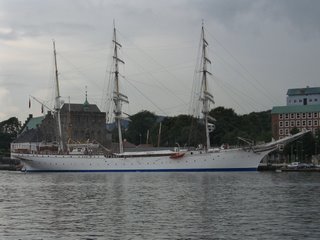 Staadsrad Lehmkuh, Bergen
Staadsrad Lehmkuh, BergenOn the quay there is a busy market. It is actually the only one we have seen in Norway, unlike most of the other countries where they are very much a part of everyday life. This one exists almost exclusively for the tourists and centres on the fish market with stalls of dressed crab, smoked salmon, caviar, and cooked prawns as the main products for sale. To ensure Norwegian authenticity there are also dried fish stacked up and dried salted cod conveniently packaged for export.
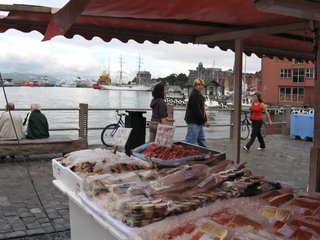 Stall in the fish market, Bergen
Stall in the fish market, Bergen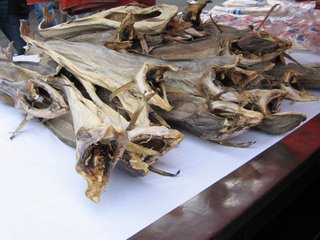 Gaping jaws of dried fish, Bergen
Gaping jaws of dried fish, Bergen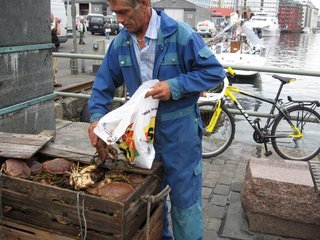 Live crabs straight from the fjord, Bergen
Live crabs straight from the fjord, BergenHere fresh rolls filled with prawns, salad and crabmeat were selling like hot cakes at £7 each to visitors without a sufficiently large purse to afford the fish and chips on offer – a snip at £14 per portion! Norway is not the location for anyone on a budget.
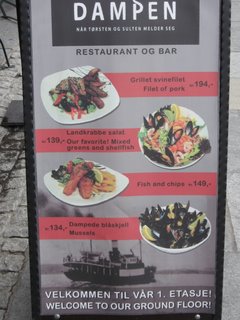 Cheap end of the range eating place in Bergen
Cheap end of the range eating place in BergenThe market has a lively atmosphere with a range of other stalls selling goods typical of Norway. These include elaborately patterned thick woollen gloves, socks, scarves and jumpers in a huge range of colours and designs and ugly looking trolls with fluffy hair, huge noses and no teeth. They are Norway's answer to the garden gnome.
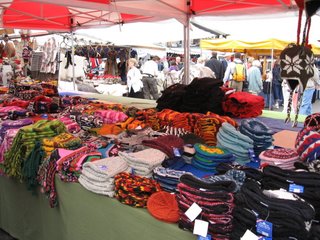 Norwegian knitted goods, Bergen
Norwegian knitted goods, BergenThere are stalls selling local specialities like brown cheese, cloudberry jam, dried elk sausage and reindeer meat. We tried as many free samples of these as we could which helped the budget a bit. One stall which aroused a great deal of interest for two opposing reasons was the one selling animal pelts and seal skins. It was surprising how many people were stroking them and bargaining to buy a silky black sealskin or a reindeer pelt whilst others looked on with distaste, unable even to touch them. We definitely fell into the latter category. The sight of Arctic wolves pelts hung up by their back legs, their heads, tails and front legs left dangling, was truly horrid. That such beautiful creatures should suffer such indignity simply because of their skin shows just how primitive we still are. As part of a united Europe we can only hope legislation will eventually bring a stop to it all.
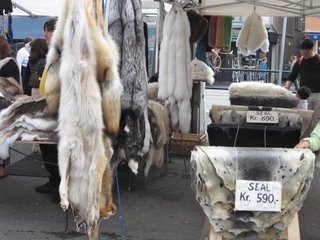 Seal skins, arctic fox furs, elk skins and wolf pelts for sale in Bergen
Seal skins, arctic fox furs, elk skins and wolf pelts for sale in BergenBehind the market are a number of large wooden warehouses. They are used as tourist shops selling woollen goods, clothing and glassware. It is surprising how easy it is to buy a wine glass here and how difficult it is to fill it! This is the area that is designated a World Heritage site. It is certainly attractive with its cobbled streets and huge, overhanging storeys, protecting the area below from the weather. The pinewood buildings are being gradually restored using traditional methods and tools. Nearby huge split timbers were stacked to dry and a sample section of timber showed how it was dovetailed to its neighbour to form walls and corner joints.
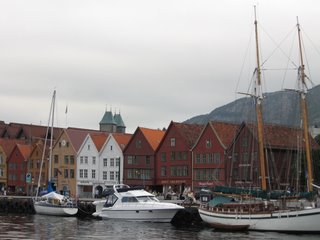 Bryggen, a Unesco world heritage site, Bergen
Bryggen, a Unesco world heritage site, Bergen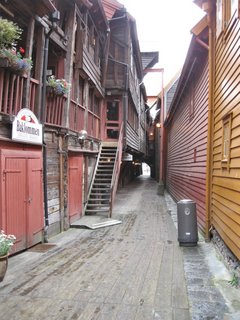 Back street in the Bryggen shopping complex, Bergen
Back street in the Bryggen shopping complex, Bergen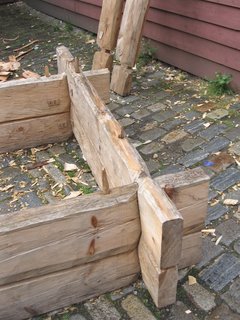 Showing corner jointing, Bryggen, Bergen
Showing corner jointing, Bryggen, Bergen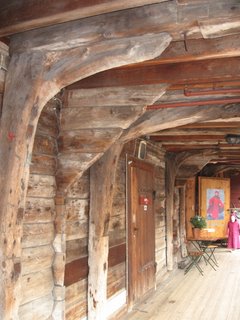 Forked trunks generally form the support for overhanging storeys, Bryggen, Bergen
Forked trunks generally form the support for overhanging storeys, Bryggen, Bergen Concrete forms the support for overhanging storeys at the Art Museum, Bergen
Concrete forms the support for overhanging storeys at the Art Museum, BergenWe are back in the land of the Japanese tourists. They ask you to take their photo and then stand there making a two fingered sign at you while you do it! Why? What does it mean in Japan? Ian had to be forcefully restrained from turning the tables on them when he wanted to ask one of them to photograph us sticking up two fingers! We found a statue to the Norwegian violinist Ole Bull, and as with Strauss in Vienna, we had difficulty in finding a moment to take a photo between the Japanese queuing to pose with him.
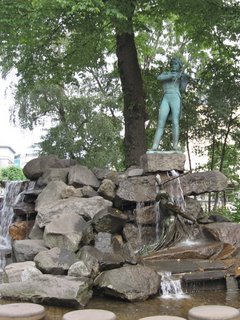 Statue of the Norwegian musician Ole Bull, Bergen
Statue of the Norwegian musician Ole Bull, BergenFor lunch we shared a prawn roll sitting on a fish trolley at the quay, along with many other tourists while the restaurants stood almost empty. We later discovered a stall selling pancakes with Norwegian fruit jam and cream which we ate with coffee in paper cups sitting on a nearby bench. Not the height of luxury but good fun and the cheapest meal in Bergen.
A walk around the town took us to some pleasant residential streets of wooden houses and up to a military installation which offered good views over the harbour and the town. We also discovered the museum of the Norwegian Resistance movement that gave us a little insight into the situation here during the war when it was under nazi occupation. It was not the best arranged museum we have visited but it was free, the staff were lovely and the toilets the best – the only ones – in Bergen.
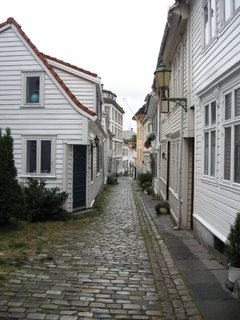 Residential street above the port, Bergen
Residential street above the port, Bergen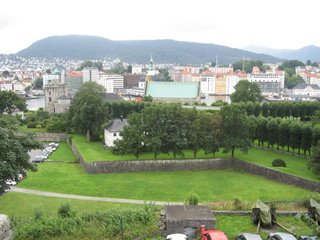 View over Bergen from the military fort at Sverresborg
View over Bergen from the military fort at SverresborgWe also discovered a wooden house that had been the home of the founder of the Buekorps in the 1850s. They were a Norwegian version of the Boys' Brigade and apparently part of their drill was to practice with crossbows! In the same house was born Armaur Hansen, who in 1873 discovered the micro-organism that causes leprosy thus leading to its control. There is a museum of leprosy in the former sanatorium here.
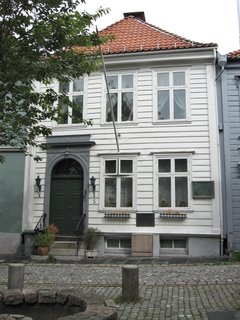 Birthplace of Armaur Hansen and home of the founder of Buekorps, Bergen
Birthplace of Armaur Hansen and home of the founder of Buekorps, Bergen Bust of Armaur Hansen, Bergen
Bust of Armaur Hansen, BergenWe have been surprised to discover now scruffy and dirty Bergen is. There are paper wrappers and cigarette ends lying around and places often seem grubby and neglected. After Denmark, where streets are spotless and there is an unbelievable number of immaculately clean public toilets everywhere you go, Norway comes as quite an unwelcome surprise. We have already mentioned that a charge is levied on drinks containers. People frequently don't bother to return them and they can often be seen lying in gutters or left in parks. There is an unofficial cleansing service in the town though, with ragged "down and outs" scavenging the streets and bins in search of enough containers to fill their plastic bags. These they then take to the barcode reader at the supermarket and get back a kroner for each one! Unfortunately, their bin searches often result in the rest of the contents being tipped around the street.
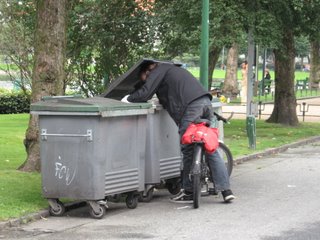 Searching for coke cans, Bergen
Searching for coke cans, BergenBergen has a number of interesting museums but first one needs to see the city. So we have not yet visited anywhere properly. For £17 it is possible to buy a card for a day to see and do everything. However, it is physically impossible to do more than a fraction of them so it doesn't look very good value. At the tourist office we noticed a sign stating there was no more accommodation available in Bergen, listing the nearest places in the surroundings where rooms could still be found. They were even reduced to listing places in Voss, where we found ourselves yesterday – 99 kilometres away!
It started to rain as we returned to Modestine on the bus and has continued to rain all evening. We are thinking of exploring some of the islands to the north of the city tomorrow but campsites are very few though the scenery should be wonderful. That is where Norway excels. By land and sea the countryside is sublime. But what a difficult place in which to live from the viewpoint of climate and communication!
Saturday 26th August 2006, Hundvin on Lindås Peninsula, Norway
Today has been quite a contrast to yesterday. We left the campsite quite late having caught up on photos and prepared a new blog for uploading if the chance occurred. It has been a warm, bright, sunny day though both morning and evening get rather chilly now. We have decided to explore some of the many islands and headlands further north for a couple of days rather than continue on the Bergen campsite. We can return later ready to catch the ferry on Thursday. We are almost at the northernmost limit of our map of southern Norway and it only shows a couple of campsites on any of the islands we can conveniently reach. So first we travelled a short distance north of Bergen on the E39 – the same magic route we have followed for much of the way up from Kristiansand. This took us across the Nordhordland Bridge which, at 1,610metres in length, we are reliably informed is the world's longest pontoon bridge without lateral anchorage!
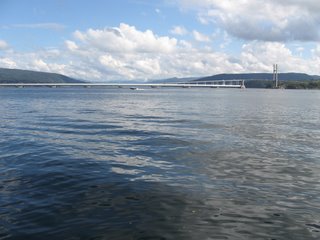 Nordhordland Bridge
Nordhordland BridgeLook! No lateral anchorage!
Once on the island of Holsnøy, with a total population of around 5,000, we stopped at the island's commercial centre in Frekhaug where the librarian allowed us free internet to load on our latest travel account. There is no campsite at all on the island but we explored to the furthest tip, some 25 kilometres further on anyway. Here we found what peace and tranquillity really are. The island simply narrowed away to nothing leaving us on a tiny jetty where the only sound was the lapping of the waves against the walls of a wooden boathouse. Nearby stood a pretty wooden house with a beautiful garden of dahlias and a vista of the sea - looking more like a lake with the tip of the next island just a short hop across the water. Looking at a map it is apparent just how ragged Norway's coastline is, but surprisingly, you are not particularly aware of this when driving along the islands until you are confronted by a dead end or a ferry. The landscape on the further end of Holsnøy consists mainly of heathland and pine forest surrounding a massive outcrop of rock. Tiny hamlets of wooden houses and a few farms are all there is to see. Nearer the mainland there is a golf course and meadowland with cattle and sheep.
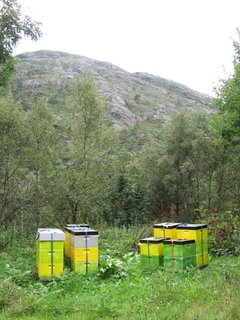 Beehives in the heather of Holsnøy
Beehives in the heather of Holsnøy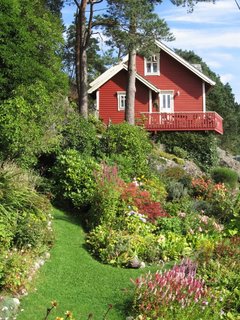 House at the far tip of Holsnøy
House at the far tip of Holsnøy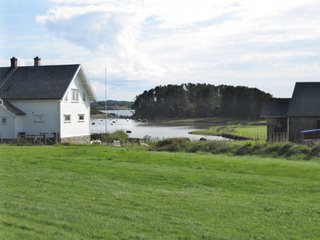 Rural calm on Holsnøy
Rural calm on Holsnøy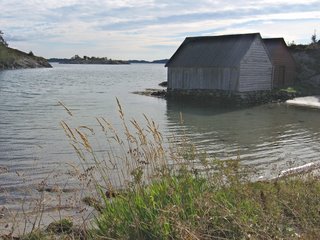 Boathouse at the furthest tip of Holsnøy
Boathouse at the furthest tip of HolsnøyReturning to the bridge from Bergen we continued to the next island (Ian has just found a map covering further north and declares it isn't actually an island but is the Lindås peninsula with the most westerly point on the mainland of Norway nearby.) Here we found one of the only campsites anywhere in the area. It is really lovely with a farm, a lake, nice views and complete peace. We walked down to scratch the pigs behind the ears as they grunted in their mud patch, we stroked the rabbits and chatted with the goat. We sat watching a toad crawling around Modestine as we ate supper and have now moved inside as it is chilly and night is falling.
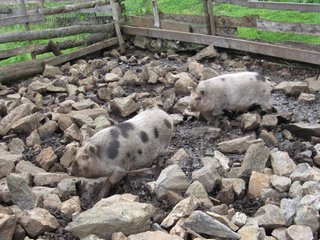 Pet pigs on the campsite at Hundvin
Pet pigs on the campsite at HundvinIt has been a peaceful, relaxed day surrounded by beautiful scenery. It may be less dramatic than the icy peaks and deep lakes of inland Norway, but on the map it is obvious just what a curious terrain it is. Its very remoteness gives it peace and charm. Its woods of birch trees and pines, its heathers, rowan trees, wild raspberry bushes, its craggy boulders and towering rocks, its coves, tiny islets, fishing huts on the shore and boats rocking on the frighteningly deep, clear water all make it the perfect location to escape the international bustle of Bergen.
Ian has now discovered we are not a stone's throw from the world's most northerly beech forest! Who would have imagined so many superlatives would exist on a couple of tiny Norwegian islands!
Sunday 27th August 2006, Rågenes on Radøy Island, Norway
This morning began overcast but dry and we explored the remainder of the campsite which has several walks into the surrounding woodland. A round, grass-covered wooden building attracted our attention. The large wooden doors opened to reveal an interior with benches around the walls covered with furs. In the middle were further benches surrounding a central open hearth from which a copper chimney carried smoke out through the point of the roof. The whole was lit by candles and was presided over by the head and antlers of a stag. Such a building is known as a lavvo. This one was a copy of the traditional dwellings of the Sami or Laplanders, used no doubt only for cold-weather barbecues, but several hundred kilometres further north they are also used as sleeping quarters.
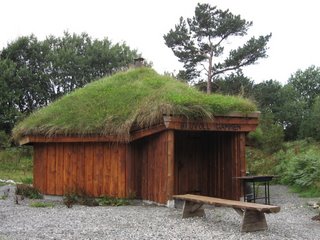 Lavvo at Hundvin
Lavvo at Hundvin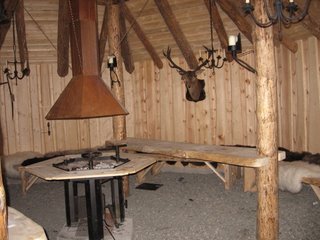 Interior of the lavvo at Hundvin
Interior of the lavvo at Hundvin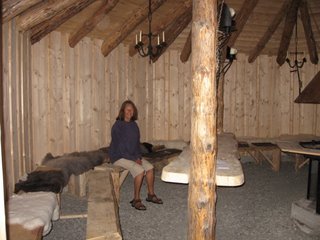 Before leaving the campsite Jill paid a visit to the lavvo
Before leaving the campsite Jill paid a visit to the lavvoWe walked through the gentle countryside of farms with herds of sheep browsing by wooden farmhouses in meadows between pine forests and rocky outcrops down to the harbour of Hundvin. The nature of the terrain means that there are very few settlements of any size in this part of the country, individual farms or small wooden hamlets are normal and the wooden church of Hundvin stood alone on a grassy height. At the peaceful harbour a rowing boat was setting out from the quay to fish the still waters of the fjord while we looked at the smaller fish that swarmed around the rocks by the shore.
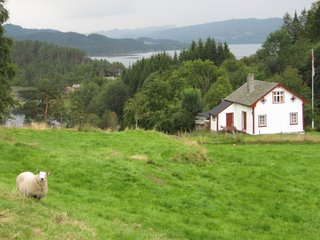 Farmstead at Hundvin
Farmstead at Hundvin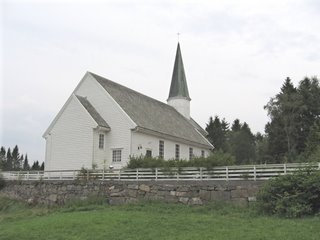 Wooden church at Hundvin
Wooden church at Hundvin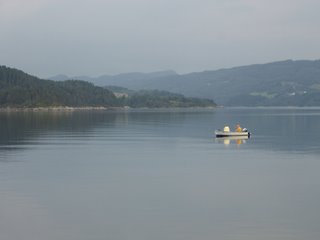 Fishing at Hundvin
Fishing at HundvinA thin mizzle started and we made our way back to Modestine, sheltering under trees when we could, leaving the campsite to drive to the north-east point of the peninsula with the idea of possibly catching the ferry at Leirvåg.
Although a ferry was unloading as we arrived we decided against it as it would have meant quite a long detour, so we contented ourselves with exploring the beautiful countryside of heathland and lakes with contorted and worn metamorphic rocks breaking up the landscape and peppering the offshore waters with innumerable tiny islands. The road wound through this scenery, which offered breathtaking perspectives at every turn, crossing from island to island on bridges until it eventually reached Sævrøy, where a ferry crosses to the island of Fedje.
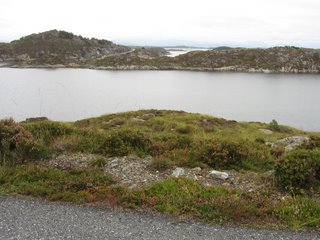 The winding road out to Sævrøy
The winding road out to SævrøyBeside the quay a family were angling. As we watched they landed a pollock which gave us the doubtful pleasure of watching it killed and cleaned in the water of the fjord, its entrails returned as bait for a future catch.
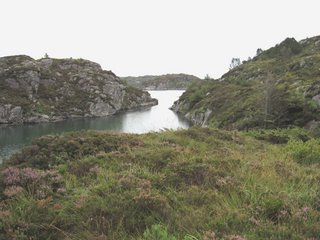 Inlet near Sævrøy
Inlet near Sævrøy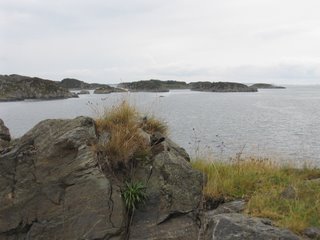 Scatter of islands near Sævrøy
Scatter of islands near Sævrøy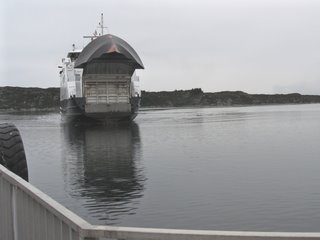 Ferry preparing to dock at Sævrøy
Ferry preparing to dock at SævrøyThe rain had stayed with us intermittently all day and we had eaten lunch inside Modestine, but now we braved the elements to walk along a quiet byroad amid this natural gigantic rockery, passing through cuttings which showed only too clearly the violent past of the earth in the twisted, contorted layers of rock, coiled and folded like plastacine. Bands of white quartz alternated with layers of black schist giving the appearance of zebra skin or a giant humbug!
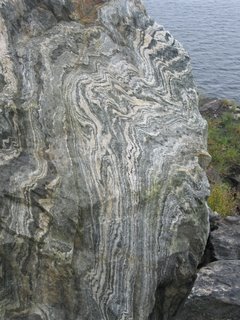 Metamorphic contortions near Sævrøy
Metamorphic contortions near Sævrøy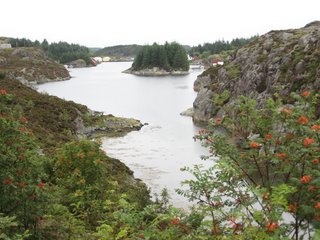 Fjord near Sævrøy
Fjord near Sævrøy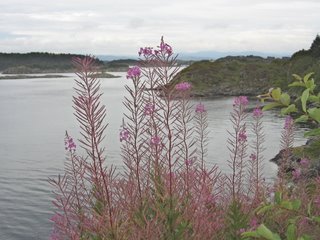 Rose bay willow herb near Sævrøy
Rose bay willow herb near SævrøyWith the island so narrow that the sea could be seen on either side, it still managed to find space for a long, deep lake covered in water lilies, a freshwater delight for a number of isolated ducks.
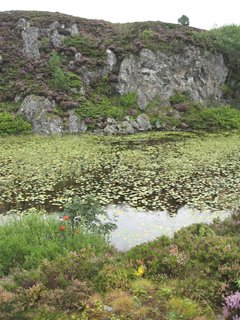 Freshwater lake near Sævrøy
Freshwater lake near SævrøyWe returned to Modestine and crossed onto the island of Radøy where we discovered our present campsite set above the Mangerfjorden. We have perched Modestine atop the highest grassy knoll in the campsite so that we can see over the roofs of the wooden huts to the islands in the fjord while staying snug from the rain which continues to beat down outside.
Despite the weather though, we have spent a very enjoyable and restful day, the rain showing the splendours of the landscape in a new mood which has its own charm. Distant silhouettes of hills are a hazy blue while the colours of the flowers, rocks and trees in the foreground are enhanced by the wet. The surfaces of the still, deep waters are pockmarked by the raindrops spreading ripples that brush gently against each other - quite mesmerising to watch.
Monday 27th August 2006, Bergen, Norway
Tonight we find ourselves back on the less than idyllic campsite on the outskirts of Bergen. We have been forced back here by the rain and lack of anywhere to camp out on the islands.
It rained continuously all night, a very comforting sound on the roof when you are snug inside Modestine, but rather dismal to wake up to next morning when you find the campsite waterlogged and you have to splosh through puddles to the communal facilities. This wasn't too bad actually as the season was over and the few people around were all staying in rented wooden cabins with grass growing on the roof. They had their own facilities which left the smart wooden toilet hut with under-floor heating just for us. It was chilly enough to appreciate the heating. It felt rather like a Swedish sauna in there after a shower.
The sea looked grey and dismal through the morning mist as we left the site, Modestine's wheels skidding in the mud. What does one do on a stunningly beautiful island on a wet Monday when there is nowhere to go and nowhere to park? There are no pull-offs from the road and in any case the terrain does not make for easy walking, rain or no rain. The only tourist attraction is the museum of the Norwegian knitting industry. Despite our sudden, burgeoning interest in the cottage industry of patterned woolly hat production, on arrival we discovered it to be closed on Mondays!
The Knarvik shopping complex boasts sixty shops and three cafés! It is just like a boring shopping complex in Wrexham or any other British town except that the prices are three times higher. We actually saw a kitchen rubbish bin for 1340 NOK! (About £120!) We did not notice anywhere selling wine and are left with the horrifying thought that possibly the island natives are reduced to travelling all the way to Bergen before they can buy a bottle of Corbières from the government controlled vinmonopolet for a minimum of £10 per bottle! We have never seen a country where everyone drinks so much Fanta and Coca Cola. Government control of wine is playing right into the hands of the soft drinks producers, and even where wine is available it is selected nationally so there is no real choice and no opportunity to try wines from small, independent producers.
Seeing the symbol for a special monument we turned in at a gateway, only to discover it was the national rhododendron collection, that we were the only people who had turned up all day and it was £4 each to look at rhododendrons that were not even in flower. So we gave the garden a miss in the rain and simply used the car park to prepare lunch.
We had no idea what we would be eating when we opened the tin, having seen it on the supermarket shelves and bought it for the label. So today we had Sodd for lunch! Later, in a bookshop where we sought shelter from the rain we discovered a Norwegian-English dictionary. It appears Sodd is a kind of meat stew with vegetables. We appreciate this explanation as the contents of the can were as anonymous and uninspiring as the Kjøttboller we had a few days ago. Both these cans appear to be popular brands on supermarket shelves and cost over £3 each! The everyday Norwegian diet seems the most uninspiring and expensive we have encountered anywhere! We are really looking forward to getting back to Britain so we can eat something other than frankfurters, potato salad, fish balls, sausagemeat balls and the contents of mystery tins with seductive labels that belie their contents.
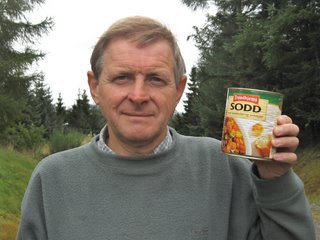 Two silly sodds
Two silly soddsIn the supermarkets here most vegetables come individually sealed in a shrink-wrapped plastic condom. It came a complete revelation to Ian, used to eating courgettes from our own garden. He is now concerned that for years he has been thoughtlessly indulging in unprotected veg!
Maybe it is because we are mentally prepared for the end of our wonderful journey through Europe, maybe it is just that it has been raining incessantly throughout the day and there is nowhere to go out on the beautiful islands, but we have found the day has dragged rather and we would really like to be on our way home now instead of hanging around waiting for the ferry. We returned to this campsite this evening and will go into Bergen tomorrow, concentrating on galleries and museums. Unfortunately we find the city horrendously expensive to travel to, to visit the museums and to eat or drink.
By the way, we suspect some of you were slightly sceptical about the account of the troll holes on the streets of Randers back in Denmark. We have just discovered a photo we forgot to put on the blog back then. As you see, it shows one of the trolls actually popping up beneath our feet in the town! So, far from pulling the wool over your eyes, we were spinning a yarn as fine as any used in the production of Norwegian knitted goods!
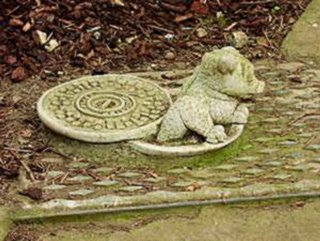 Troll emerging from troll hole in Randers
Troll emerging from troll hole in Randers